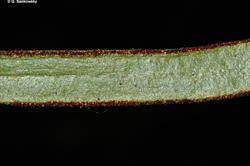Pteridaceae
Australian Tropical Ferns and Lycophytes - Online edition
Haplopteris ensiformis
Haplopteris ensiformis (Sw.) E.H.Crane
Link to Australian Plant Name Index for publication details and synonyms: https://id.biodiversity.org.au/name/apni/51294662
Tape Fern, Ribbon Fern
Rhizome very short-creeping, branched, densely scaly, thickly covered with dark roots with spreading ginger hairs; scales 4–8 mm long, very slender; walls of inner cells thick and blackish; outer cell walls thinner and brown; apex hair-like with curved marginal teeth. Fronds crowded. Lamina linear to narrowly elliptic or narrowly oblanceolate, 10–50 cm long, 2–6 mm wide, tapered to both ends, dark green, glossy, coriaceous, erect to semi-erect and ±falcate to pendulous; midvein obscure; lateral veins very oblique. Paraphyses branched; terminal cells clavate, c. 2 or 3 times as long as wide.
In Australia it occurs in wet areas of the NT and QLD. Widespread in the Palaeotropics and subtropics.
Epiphytic on trees or decaying logs or lithophytic on boulders and rockslopes, usually in rainforest, occasionally in wet sclerophyll forest.
Readily cultivated in moist tropical climates in a hanging basket, on a slab or planted in the base of an epiphytic nest fern. This species resents disturbance but grows well once established.
Haplopteris ensiformis and H. elongata are often confused. The rhizome of H. elongata is short to moderately long creeping and has uniformly coloured scales whereas the rhizome of H. ensiformis is very short creeping and has scales with a darker middle band and slightly paler margins. The fronds of H. elongata are generally flatter, broader and lighter green and new growth has a more revolute crozier than H. ensiformis, which has fronds that are somewhat thicker and sometimes cupped in cross section, darker green and with a less revolute crozier. Some plants of H. elongata from hot lowland tropical swamp forests are very large, have broad apple green fronds and a long creeping rhizome, and they can invade the nests of other epiphytes and form large colonies.
Field AR, Quinn CJ, Zich FA (2022) Australian Tropical Ferns and Lycophytes. apps.lucidcentral.org/fern/text/intro/index.htm (accessed online INSERT DATE).
Field AR, Quinn CJ, Zich FA (2022) ‘Platycerium superbum’, in Australian Tropical Ferns and Lycophytes. apps.lucidcentral.org/fern/text/entities/platycerium_superbum.htm (accessed online INSERT DATE).









